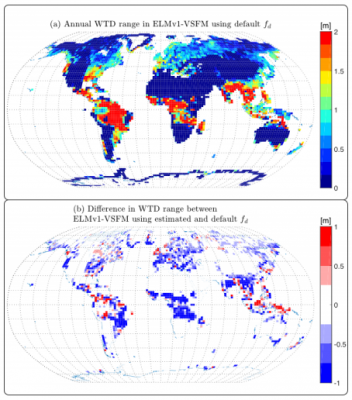Unified Treatment of Hydrologic Processes in Unsaturated and Saturated Zones Within the E3SM Land Model
Improving global-scale model representations of near-surface soil moisture and groundwater hydrology is important for accurately simulating terrestrial processes and predicting climate change effects on water resources. Yet, most existing land surface models routinely employ different formulations for water transport in the near-surface unsaturated and deeper saturated zones. In this work, we developed the Variably Saturated Flow Model (VSFM) in ELMv1 to unify the treatment of soil hydrologic processes in the unsaturated and saturated zones. Drainage parameterization of the ELMv1-VSFM was calibrated to match an observationally-constrained and spatially-explicit global water table depth (WTD) product.
Comparison with predictions using the default drainage parameter value demonstrated that calibration significantly improved predictions, primarily by allowing much deeper WTDs. Model evaluation using the International Land Model Benchmarking (ILAMB) package showed that improvements in WTD predictions did not degrade model skill for any other metrics.
A recent review of hydrologic processes in current generation land surface models identified inclusion of a variably saturated subsurface flow model as an important requirement for improving simulation of coupled soil moisture and shallow groundwater dynamics. In this work, we developed an isothermal, single phase, one-dimensional, variably-saturated flow model in ELM. We used the PETSc library to provide numerically robust solutions to the nonlinear discretized equations of VSFM. The new model was tested on three benchmark problems and results were evaluated against observations and an existing benchmark model.
The ELMv1-VSFM’s subsurface drainage parameter, fd, was calibrated to match an observationally-constrained and spatially-explicit global WTD product. Optimal spatially-explicit fd values were obtained for 79% of global 1.90 × 2.50 gridcells, while the remaining 21% of global gridcells had predicted WTD deeper than the observationally-constrained estimate. Comparison with predictions using the default fd value demonstrated that calibration significantly improved predictions, primarily by allowing much deeper WTDs. The modular software design of VSFM not only provides flexibility to configure the model for a range of problem setups, but also allows building the model independently of the ELM code, thus enabling straightforward testing of model’s physics against other models.

